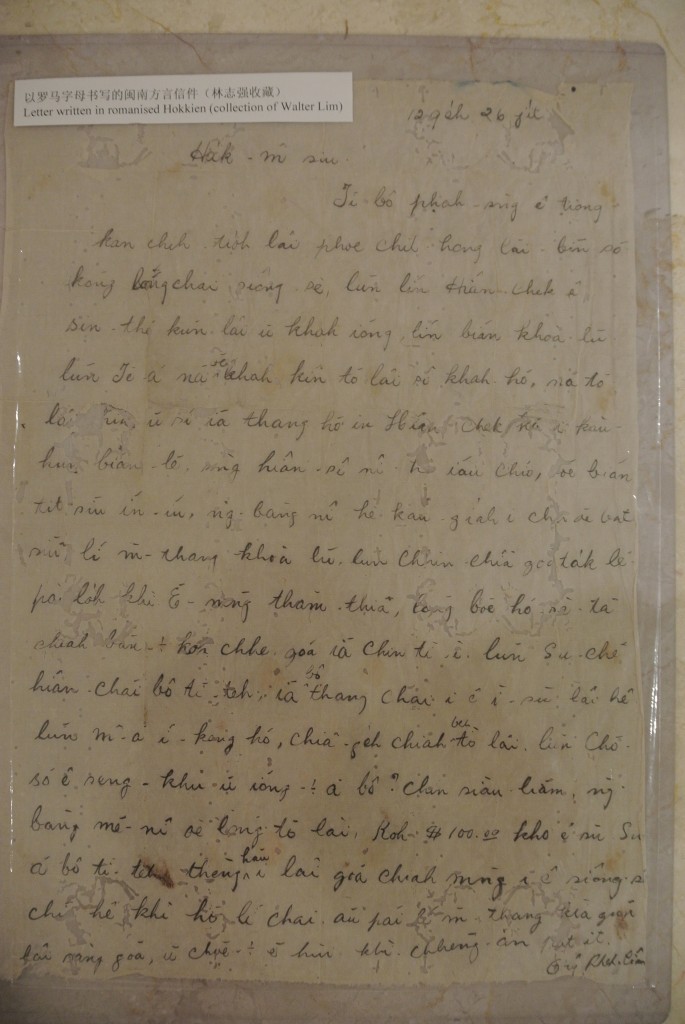“The Letter”
2
A letter in Romanized Hokkien , or Pe̍h-ōe-jī as it is known, on display at the exhibition Our Roots, Our Future, piqued the interest of many. But no one could fully decipher its meaning. A challenge was sent out to the Singapore Heritage Bukit Brown Cemetery FB group. It caught the eye of 卓育興 Yu Hsing Jow who is a Taiwanese living in Singapore researching on Hokkien culture here. He alerted an expert from Xiamen, Lim Kian Hui. who was able to help decipher and translate the the letter.
卓育興Yu Hsing Jow translated it into Mandarin, and from Mandarin, we finally have an almost full English translation by Brownie Ang Yik Han. It reads:
Hàk-ḿ: (the letter is addressed to a woman named Hak)
I received a letter out of the blue which covered many details. Your uncle’s health is better, please don’t worry. If his son can return it will be better, as your uncle can teach and encourage him. He is young and susceptible to temptations, hopefully he will be wiser when he is older, please don’t worry. As for the relatives, they are not in good condition when I visit them in Amoy every week, but I am not too concerned. Your senior is not here now, I have no wish to inform her as well, but she will be back in the first lunar month. How are the sisters-in-law? They are so young, I wish they can be back every year. Also, there is the matter of the $100. The teacher is not in school, I will enquire about him later. As for this mark (unclear what this is) , please do not send it to me in the future, it takes a lot of effort. Take care.
The content is representative of letters that would have been exchanged by families and friends separated in the Chinese Diaspora. It covers in one page an update on financial matters and the domestic situation at home, but the tone of the letter also expresses care, concern and reassurance.
Here is the letter transcribed in Pe̍h-ōe-jī by 卓育興 Yu Hsing Jow
Ha̍k-ḿ siu
Jí-bô phah-sǹg ê tiong-kan, chiap-tio̍h lâi phoe chit hong, lāi-bīn sō kóng long chai siông-sè . lūn lín hiân-chek ê sin-khu, kūn lāi ū khah iōng, lín bián khoà-lū. lūn jī á nā-sī khah kín tò-lâi pó khah hó. Nā tò-lâi chia, ū sî iā thang hō͘ in hiân-chek khah I kàu-hùn, bián-lē. sǹg hiân-sî nî-hè iáu chió, bē bián tit-siū ín-iń, ng-bāng nî-hè kàu gia̍h i chiū ē bat siūⁿ . lí m̄-thang khoà-lū. lūn chhin-chiâⁿ goá ta̍k lé-pài lo̍h khì Ē-Mn̄g thām thiā, long boē hó-sè. Tā-chiah chia bān-bān koh chhōe, goá iā chin tì-ì . lūn su-chē hiân-chai bô tī the, iā thang chai ié ī-sū. Lái heⁿ lun̄ mā ái kóng hó, chiaⁿ-ge̍h chiah beh tò-lâi. Lūn chō sō ê seng-khu ū ióng-ióng á-bô. Chin siàu-liân ǹg-bāng mê-nî ē long tò-lâi, koh $100.00 kho ě sū. Suá bô ti-teh thēng hāu-lâi,góa chiah mn̄g I ê siông-sè, chit ê kì-hō,lí chai āu-pái m̄-thang kià kòe lâi sàng góa, ū chōe chōe êhùi khì. Chhéng an put it.
Ông pheh lîm
Many thanks to 卓育興 Yu Hsing Jow for the transcription and his time spent in helping to translate the letter. He has since included the letter to the Wikipedia on Singaporean Hokkien
About the letter:
The Letter was donated to the exhibition Bukit Brown: Our Roots,Our Future, by a descendant of Tan Boon Hak, cousin of Tan Kah Kee)


Hi
I googled my great grandfather tan boon hak’s name and came across this. There are several letters and wills written to or by tan boon hak in very old Chinese words, some dating back to 1890+s. Can you help to decipher? There’s also a very old dress from Qing Dynasty that was discovered when we found the letters but we are not sure if it belongs to my great grandmother (tan boon hak’s wife).
Eileen
Hi Eileen,
Have replied to you via email. Thanks